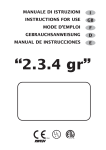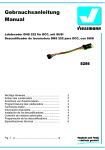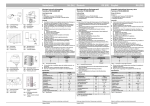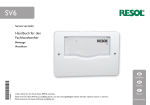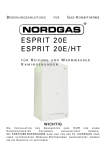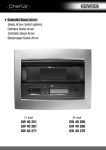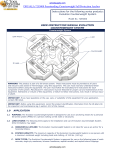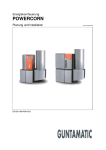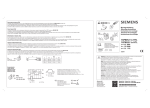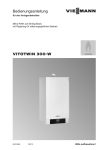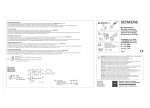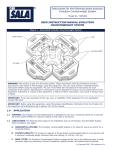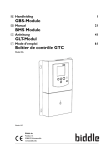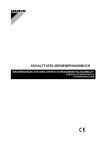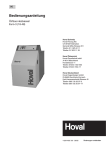Download SA - EM10
Transcript
7213 8100 – 06/2005 EU Serviceanleitung Externe Störungsanzeige Modul EM10 für UBA 3/EMS/MC10 Heizkessel Serviceinstructie Externe storingsaanduiding EM10 voor UBA 3/EMS/MC10 cv-toestellen Service instructions External Error Detection EM10 for UBA 3/EMS/MC10 boilers Instructions d'utilisation Détection de panne externe EM10 pour chaudières avec UBA 3/EMS/MC10 Istruzioni d’uso Avviso di disfunzione esterna Modulo EM10 per caldaie con UBA 3/EMS/ MC10 Deutsch . . . . . . . . . . . . . . . . . . . . . . . . . . . . . . . . .3 Nederlands . . . . . . . . . . . . . . . . . . . . . . . . . . . . . .6 English . . . . . . . . . . . . . . . . . . . . . . . . . . . . . . . . .9 Français . . . . . . . . . . . . . . . . . . . . . . . . . . . . . . .12 Italiano . . . . . . . . . . . . . . . . . . . . . . . . . . . . . . . .15 Das Gerät entspricht den grundlegenden Anforderungen der zutreffenden europäischen Richtlinien. Die Konformität wurde nachgewiesen. Die entsprechenden Unterlagen und das Original der Konformitätserklärung sind beim Hersteller hinterlegt. Dit apparaat voldoet aan de eisen van de betreffende Europese richtlijnen. Conformiteit is aangetoond. De betreffende documenten en de originele conformiteitsverklaring zijn bij de fabrikant gedeponeerd. This appliance is in conformance with the requirements of the applicable European directives. Conformity has been substantiated by the proper documents which - together with the declaration of conformity - are filed with the manufacturer. Cet appareil répond aux exigences de base des directives européennes correspondantes. La conformité a été prouvée. La documentation correspondante ainsi que l’original de la déclaration de conformité ont été déposés auprès du fabricant. L’apparecchio è conforme alle esigenze basilari delle pertinenti direttive europee. La conformità dell’impianto è stata certificata. La documentazione corrispondente unitamente all'originale della dichiarazione di conformità sono disponibili presso il costruttore. 2 06/2005 Modul EM10 Deutsch Deutsch Bestimmungsgemäße Verwendung AS (24V) z Das Modul EM10 kann an einen Heizkessel mit UBA 3/EMS/MC10 angeschlossen werden. AS (230V) Funktion des Moduls EM10 – Das Modul EM10 meldet alle verriegelnden Fehler. Anlagenfehler und Wartungsmeldungen erzeugen keine Sammelstörmeldung. – Das Modul EM10 reagiert nicht auf Störungen externer Regelungen, die an den Heizkessel angeschlossen sind. – Zusätzlich kann der Sollwert der Vorlauftemperatur des Heizkessels über eine externe Steuerspannung von 0 – 10 V (Gleichspannung) vorgegeben werden. – Oder kann die Leistung anhand eines externen Steuerungssignals gesteuert werden. 1 Montage z Montieren Sie das Modul EM10 wie in der beiliegenden "Montageanweisung Funktionsmodul xM10" beschrieben. Anschluss z Das Modul EM10 über ein zweiadriges Kabel vom Anschluss EMS (Abb. 1, Pos. 1) an den RC-Anschluss der Klemmenleiste des Heizkessels (Abb. 1, Pos. 2) anschließen. Der Anschluss ist polaritätsabhängig. 2 Abb. 1 Störmeldung Die vom Modul EM10 generierte Störmeldung wird in 2 unterschiedlichen Formen ausgegeben: a) AS 24 V-Kontakt (Abb. 2, Pos. 1) Bei dem AS 24 V-Kontakt handelt es sich um einen potenzialfreien Umschaltkontakt für Signalkleinspannung bis 24V, der z.B. von einem Gebäudeautomationssystem ausgewertet werden kann. AS 24V keine Störung Störung 1 und 2 unterbrochen geschlossen 2 und 3 geschlossen unterbrochen Siehe auch "Elektrischer Schaltplan", auf Seite 19. b) AS 230V-Kontakt (Abb. 2, Pos. 2) Bei dem AS 230V-Kontakt handelt es sich um einen 230V-Kontakt, der z.B. zum Ansteuern von einer Hupe oder Störmeldelampe verwendet werden kann. Bei Störung liegt an 2 und 4 des AS 230V-Anschlusses 230V Spannung an. Das Störungssignal wird aktiv, wenn: – der UBA 3 eine verriegelnde Störung hat, oder – der Anlagendruck zu niedrig ist, oder – die Kommunikation mit dem Heizkessel seit mindestens 5 Minuten unterbrochen ist. Änderungen aufgrund technischer Verbesserungen vorbehalten! Modul EM10 • 06/2005 Anschluss Modul EM10 an Heizkessel (als Beispiel hier: Logamax plus GB142 und eine Wandmontage der Module) AS (24V) AS (230V) 3 Abb. 2 2 1 4 Anschlüsse W 3 Deutsch Modul EM10 Der EM 10 kann als Interface zwischen dem Heizkessel und beispielsweise einem Gebäudeverwaltungssystem verwendet werden. Anhand eines 0-10 VDC-Signals ist eine Steuerung über die Leistung sowie über die Vorlauftemperatur möglich (Abb. 3). Steuerung über die Vorlauftemperatur Der EM 10 überträgt das 0-10V-Signal des Gebäudeverwaltungssystems auf einen Vorlauftemperatursetpoint. Hierbei handelt es sich um ein lineares Verhältnis (Tabelle 1). Eingangsspannung [V] Vorlauftemperatur-setpoint (Heizkessel) [°C] Zustand des Heizkessels 0 0 aus 0,5 0 aus 0,6 ± 15 ein 5,0 ± 50 ein 10,0 ± 90 ein / maximum Tab. 1 Vorlauftemperatur [°C] Externes Steuerungssignal 0-10V Abb. 3 Volt 0 – 10V Diagramm Steuerung über die Vorlauftemperatur Steuerung über die Leistung Der EM10 überträgt das Signal des Gebäudeverwaltungssystems auf einen Leistungssetpoint. Hierbei handelt es sich um ein lineares Verhältnis (Tabelle 2). Eingangsspannung [V] Tab. 2 Leistungssetpoint (Heizkessel) [%] Zustand des Heizkessels 0 0 aus 0,5 0 aus 0,6 ±6 Niedriglast *) 5,0 ± 50 Teillast 10,0 100 Volllast Steuerung über die Leistung *)Die Leistung bei Niedriglast ist vom Gerätetyp abhängig. Wenn die Niedriglast des Geräts beispielsweise 20% beträgt und das Steuerungssignal 1 Volt (= 10%) ist, dann ist die Sollleistung kleiner als die Niedriglast. In diesem Fall liefert das Gerät 10% durch einen Ein/Aus-Zyklus bei Niedriglast. In diesem Beispiel geht der Heiskessel ab einem Setpoint von 2 Volt in Dauerbetrieb. Zur Aktivierung der Leistungsregelung muss eine Überbrükkung am Lüsterklemmenanschluss des EM10 eingesetzt werden. Siehe "Anschlussschema EM 10" auf Seite 19. W 4 Änderungen aufgrund technischer Verbesserungen vorbehalten! Modul EM10 • 06/2005 Modul EM10 Deutsch Anschluss weiterer Module Sie können mehrere unterschiedliche Module (z. B. EM10 und VM10) miteinander verbinden. Um zwei oder mehr Module miteinander zu verbinden, kann der Netzanschluss (Abb. 4, Pos. 2) und der EMS-Anschluss (Abb. 4, Pos. 3) jeweils weiterverbunden werden. 3 Netzanschluss 12 z Stellen Sie den Netzanschluss her (Abb. 4, Pos. 1 und Abb. 2, Pos. 3). 2 3 Abb. 4 Zwei Module miteinander verbinden, Netzanschluss herstellen LED-Anzeigen am Modul EM10 Es gibt eine LED, die entweder rot oder grün leuchten kann. Die LED blinkt kurz rot, wenn die Netzspannung eingeschaltet wird. Zustand LED Bedeutung grün (ständig) Alles ist richtig angeschlossen. grün (blinkend) Kommunikation mit dem Heizkessel ist seit mindestens 5 Minuten unterbrochen. Reset durchführen. Zeigt der Reset keine Wirkung, Heizungsfachfirma verständigen. Siehe hierzu die Unterlagen des Heizkessels. EM10 ist defekt. Heizungsfachfirma verständigen. Siehe hierzu die Unterlagen des Heizkessels. rot (ständig) Änderungen aufgrund technischer Verbesserungen vorbehalten! Modul EM10 • 06/2005 W 5 Nederlands Module EM10 Nederlands Toepasbaarheid AS (24V) z De Module EM10 kan op een cv-toestel - voorzien van een UBA3/EMS/MC10 - aangesloten worden. AS (230V) Functie van de module – De EM10 meldt alle vergrendelende storingen. Systeemfouten, onderhoudsmeldingen en blokkerende storingenworden niet gemeld. – De module EM10 reageert niet op storingen van externe regelapparatuur, die op het cv-toestel zijn aangesloten. – Tevens kan ook de aanvoertemperatuur van het cv-toestel aangepast worden met een extern stuursignaal van 0-10V (gelijkspanning) – Of kan met een extern stuursignaal het vermogen gestuurd worden. 1 Montage z Monteer de module EM10 zoals beschreven in de bijgevoegde "Montageinstructie functiemodule xM10". Aansluiten De module EM10 d.m.v. een 2-adrige kabel aan de aansluiting EMS (afb. 1, pos. 1) en aan de RC-aansluiting van het cv-toestel aansluiten (afb. 1, pos. 2). De aansluiting is polariteitsgevoelig. Storingssignaal 2 Afb. 1 Het door de EM10 gegenereerde storingssignaal wordt op twee manieren gegeven: a) De AS 24V aansluiting (afb. 2, pos. 1) Bij de AS 24V aansluiting gaat het om een potentiaal vrij schakelcontact voor laagspanningssignalen tot 24V, die bijv. door een gebouwbeheersysteem uitgelezen kan worden. AS 24V geen storing storing 1 en 2 onderbroken gesloten 2 en 3 gesloten onderbroken Zie hoofdstuk "Aansluitschema", bladzijde 19. b) De AS 230V aansluiting (afb. 2, pos. 2) Bij de AS 230V aansluiting gaat het om een 230V aansluiting, voor het aansturen van bijvoorbeeld een claxon of alarmlamp. Bij storing staat op pin 2 en 4 van deze aansluiting 230V spanning. Het storingssignaal wordt actief op het moment dat: – de UBA3 een vergrendelende storing heeft of, – de systeemdruk te laag is of, – de communicatie met het cv-toestel tenminste 5 minuten is verbroken. Aansluiten van de module op het cv-toestel (Als voorbeeld is hier de Logamax plus GB142 met een wandmontage van de module afgebeeld) AS (24V) AS (230V) 3 Afb. 2 2 1 4 Aansluitingen Wijzigingen voorbehouden! 6 Module EM10 • 06/2005 Module EM10 Nederlands De EM10 kan gebruikt worden als interface tussen het cv-toestel en bijvoorbeeld een gebouwbeheersysteem. Door middel van een 0-10 VDC signaal kan zowel op vermogen als op aanvoertemperatuur worden gestuurd. (afb. 3). Sturing op aanvoertemperatuur De EM10 vertaalt het 0-10V signaal van het gebouwbeheersyteem naar een aanvoertemperatuursetpoint. Hierbij is het verband lineair (tabel 1). Ingangsspanning [V] Aanvoertemperatuursetpoint (cv-toestel) [°C] Status cv-toestel 0 0 uit 0,5 0 uit 0,6 ± 15 aan 5,0 ± 50 aan 10,0 ± 90 aan / maximum Tab. 1 aanvoertemperatuur [°C] Extern stuursignaal 0-10V Afb. 3 externe stuurspanning (V) 0 – 10V diagram Sturing op aanvoertemperatuur Sturing op vermogen De EM10 vertaalt het signaal van het gebouwbeheersysteem naar een vermogenssetpoint. Hierbij is het verband lineair (tabel 2). Ingangsspanning [V] Vermogenssetpoint (cv-toestel) [%] Status cv-toestel uit 0 0 0,5 0 uit 0,6 ±6 laaglast *) 5,0 ± 50 deellast 10,0 100 vollast Tab. 2 Sturing op vermogen *)Het laaglastvermogen is toestelafhankelijk. Als de laaglast van het toestel b.v. 20% is en het stuursignaal is 1 Volt (= 10%), dan is het gevraagde vermogen kleiner dan de laaglast. In dit geval gaat het toestel 10% leveren d.m.v. een aan/uit cyclus op laaglast. In dit voorbeeld gaat het toestel vanaf een setpoint van 2 Volt in continu bedrijf. Om de vermogensregeling te activeren dient een doorverbinding gemaakt te worden op de kroonsteenaansluiting van de EM10. Zie het "Aansluitschema EM10" op pag. 19. Wijzigingen voorbehouden! Module EM10 • 06/2005 7 Nederlands Module EM10 Het aansluiten van meerdere modules Het is mogelijk om meerdere verschillende modules (bijv. EM10 en VM10) met elkaar te verbinden. Om twee of meer modules met elkaar te verbinden, kan de netaansluiting (afb. 4, pos. 2) en de EMS-aansluiting (afb. 4, pos. 3) steeds doorverbonden worden. 3 Netaansluiting Sluit de netaansluiting aan (afb. 4, pos. 1 en afb. 2, pos. 3). 12 2 LED-meldingen op de EM10 module. Er is 1 LED, die of rood of groen kan oplichten. De LED knippert kortstondig rood, op het moment dat er spanning op het cv-toestel komt te staan. LED status 3 Afb. 4 Twee modules met elkaar verbinden, Netspanning aansluiten Betekenis groen (permanent) Alles is juist aangesloten. groen(knipperend) Minstens 5 minuten geen communicatie met het cv-toestel. Reset doorvoeren. Helpt de reset niet, raadpleeg dan uw installateur. Zie ook de instructies van het cv-toestel. rood (permanent) EM10 is defect. Bel uw installateur. Zie ook de instructies van het cv-toestel. Wijzigingen voorbehouden! 8 Module EM10 • 06/2005 Modul EM10 English English Range of application AS (24V) z The module EM10 may be installed in boilers equipped with a UBA3/EMS/MC10. AS (230V) Function of the EM10 – The module EM10 relays a signal when a blocking malfunction occurs in the boiler. System faults and service announcements are not reported. – The module EM10 does not react to malfunctions of any external controllers which may be installed. – In addition, the flow temperature of the boiler can be influenced by means of an external control voltage of 0 – 10 V (rectified voltage). – Or can be used to control the power using an external control signal. 1 Mounting z Mount the module EM10 as described in "Mounting instructions function module xM10". Connection z Connect the module EM10 with a two-core cable leading from the EMS-connection (fig. 1, pos. 1) to the RC-connection on the external connection board of the boiler (fig. 1, pos. 2). The connection is polarity sensitive. 2 Fig. 1 Connection module to the boiler (example pictured: shows the Logamax plus GB142 with a wall-mounted module) Malfunction signal The generated malfunction signal is given in two ways: a) AS 24V connection (fig. 2, pos. 1) The AS 24V connection is a volt-free connection for low voltage malfunction signals of up to 24V, which can be evaluated by an automated building control system. AS (24V) AS 24V connection no malfunction malfunction 1 and 2 interrupted closed 2 and 3 closed interrupted See also the "Wiring Diagram" on page 19. b) AS 230V connection (fig. 2, pos. 2) The AS 230V connection is a 230V connection which can be used to pass on an external malfunction signal to a horn or warning light. At times of a malfunction, there will be 230V on connections 2 and 4. The malfunction signal is active when: – the UBA 3 has a locking fault code, or – the system pressure is too low, or – there has been no communication with the boiler for at least 5 minutes. AS (230V) 3 2 1 4 Fig. 2 Connections Subject to changes due to technical improvements! Module EM10 • 06/2005 9 English Module EM10 The EM 10 can be used as the interface between the boiler assembly and a building management system for example. A 0-10 VDC signal can be used to enable power-based or flow temperature-based control (fig. 3). Flow temperature-based control The EM 10 transfers the 0-10V signal from the building management system to a flow temperature set point. This is a linear ratio (table 1). Input voltage [V] Flow temperature set point (boiler) [°C] Boiler condition 0 0 off 0.5 0 off 0.6 ± 15 on 5.0 ± 50 on 10.0 ± 90 on / maximum Table 1 flow temperature [°C] 0 – 10V external control signal external control voltage Fig. 3 0 – 10V Diagram Flow temperature-based control Power-based control The EM 10 transfers the signal from the building management system to a power set point. This is a linear ratio (table 2). Input voltage [V] Power set point (boiler) [%] Boiler condition 0 0 off 0.5 0 off 0.6 ±6 low load *) 5.0 ± 50 partial load 10.0 100 full load Table 2 Power-based control *)The low-load power depends on the type of appliance. For example, if the low load of the appliance is 20% and the control signal 1 volt (= 10%), the target power is lower than the low load. In this case the appliance delivers 10% using an on/off cycle with low load operation. In this example the boiler assembly starts heating continuously from a set point of 2 volts. To activate the power regulation the EM10 connectors must be bridged. See the "EM 10 connection diagram" on page 19. Subject to changes due to technical improvements! 10 Module EM10 • 06/2005 Modul EM10 English Connecting several modules It is possible to connect several different modules (Eg. EM10 and VM10) to each other. To connect two or more modules, interconnect the mains connections (fig. 4, pos. 2) and the EMS-connections (fig. 4, pos. 3). 3 Mains connection 12 z Install the mains connection (fig. 4, pos. 1 and fig. 2, pos. 3). 2 3 Fig. 4 Connecting two modules to each other, installing the mains connection LED-reports of the module EM10 There is one LED which can light up red or green. The LED flashes red for a short time, when the mains power is turned on. LED status green (permanent) Meaning Everything is connected properly. green (flashing) No communication with the boiler for at least 5 minutes. Reset the boiler. If the reset doesn’t work contact your installer. See also the instructions for the boiler. red (permanent) EM10 is defect. Contact your installer. See also the instructions for the boiler. Subject to changes due to technical improvements! Module EM10 • 06/2005 11 Français Module EM10 Français Utilisation appropriée z Le module EM10 peut être branché à une chaudière avec UBA 3/EMS/MC10. Fonction du module EM10 – Le module EM10 signale tous les défauts verrouillants. Les modules de l’installation et les messages de maintenance ne génèrent pas de message de défauts groupés. – Le module EM10 ne réagit pas à des défauts de régulations externes, raccordées à la chaudière. – De plus, la consigne de la température de départ de la chaudière peut être définie par une tension de commande externe de 0 – 10 V (tension continue). – Ou la puissance peut être pilotée au moyen d'un signal de commande externe. Montage z Monter le module EM10 comme décrit dans la "Notice de montage du module de fonction xM10" ci-joint. Raccordement z Raccorder le module EM10 à l'aide d'un câble à 2 conducteurs de la borne EMS (fig. 1, pos. 1) à la borne RC du bornier de la chaudière (fig. 1, pos. 2). Respecter la polarité lors du branchement. AS (24V) AS (230V) 1 2 Fig. 1 Branchement du module EM10 à la chaudière (Exemple ci-dessus : Logamax plus GB142 et un montage mural des modules) Message de défaut (voir aussi le schéma électrique) Le message de défaut généré par le module EM10 est émis sous deux formes différentes : a) Contact AS 24 V (fig. 2, pos. 1) Le contact AS 24 V est un contact inverseur isolé pour très basse tension jusqu’à 24 V, qui peut être exploité p. ex. par un système d'automatisation de bâtiment. AS24V 1 et 2 2 et 3 aucun ouvert fermé défaut fermé ouvert b) Contact AS 230 V (fig. 2, pos. 2) Le contact AS 230 V est un contact de 230 V, qui peut être utilisé par exemple pour commander un avertisseur sonore ou une lampe d’avertissement. En cas de défaut, une tension de 230 V est présente sur les bornes 2 et 4 du AS 230V. Le signal de défaut est activé si : AS (24V) AS (230V) 3 2 1 4 Fig. 2 Bornes – l'UBA 3 présente un défaut verrouillant ou – la pression de l'installation est trop basse ou – la communication avec la chaudière est interrompue depuis au moins 5 minutes. Sous réserve de modifications techniques ! 12 Module EM10 • 06/2005 Module EM10 Français Le EM 10 peut être utilisé comme interface entre la chaudière et par exemple un système de gestion de bâtiment. Une commande est possible à l'aide d'un signal 0-10 VDC par la puissance et par la température de départ (fig. 3). Commande par la température de départ Le EM 10 transmet le signal 0-10V du système de gestion à un SetPoint de la température de départ. Il s'agit ici d'un rapport linéaire (tableau 1). Tension d'entrée [V] SetPoint température de départ (chaudière) [°C] Etat de la chaudière 0 0 arrêt 0,5 0 arrêt 0,6 ± 15 marche 5,0 ± 50 marche 10,0 ± 90 marche / maximum Température de départ [°C] Signal de commande externe 0-10V volts Fig. 3 Caractéristique 0 – 10V Tableau 1 Commande par la température de départ Commande par la puissance Le EM10 transmet le signal du système de gestion à un SetPoint de puissance. Il s'agit ici d'un rapport linéaire (tableau 2). Tension d'entrée [V] SetPoint de puissance (chaudière) [%] Etat de la chaudière arrêt 0 0 0,5 0 arrêt 0,6 ±6 petite charge *) 5,0 ± 50 charge partielle 10,0 100 pleine charge Tableau 2 Commande par la puissance *)La puissance avec petite charge est fonction du modèle de l'appareil. Si la petite charge de l'appareil est par exemple de 20% et le signal de commande de 1 Volt (= 10 %), la puissance théorique est inférieure à la petite charge. Dans ce cas, l'appareil fournit 10 % par un cycle marche/arrêt avec petite charge. Dans cet exemple, la chaudière se met sur fonctionnement permanent à partir d'un SetPoint de 2 Volt. Pour activer la régulation de puissance, il faut installer un pontage au niveau du raccordement du bloc de jonction du EM10. Voir "Schéma de raccordement EM 10", page 19. Sous réserve de modifications techniques ! Module EM10 • 06/2005 13 Français Module EM10 Branchement de plusieurs modules Vous pouvez relier plusieurs modules différents (p. ex. EM10 et VM10). Pour relier deux ou plusieurs modules, la borne secteur (fig. 4, pos. 2) et la borne EMS (fig. 4, pos. 3) peuvent être reliés à d'autres composants. 3 Raccordement secteur 12 z Effectuer le raccordement au secteur (fig. 4, pos. 1 et fig. 2, pos. 3). 2 3 Fig. 4 Relier deux modules, effectuer le branchement au secteur Affichages LED sur le module EM10 Le LED s'allume (vert ou rouge). Le LED clignote (rouge), lorsque la tension secteur est présente. Etat LED vert (en permanence) vert (clignotant) rouge (en permanence) Signification Tout est correctement branché. la communication avec la chaudière est interrompue depuis au moins 5 minutes. Faire une remise à zéro. Si la remise à zéro n'a aucun effet, contacter l'installateur. Voir documentation technique de la chaudière. L'EM10 est défectueux. Contacter l'installateur. Voir documentation technique de la chaudière. Sous réserve de modifications techniques ! 14 Module EM10 • 06/2005 Modulo EM10 Italiano Italiano Utilizzo appropriato z Il modulo EM10 può essere collegato alla caldaia dotata di UBA 3/EMS/MC10. Funzione del modulo EM10 – Il modulo EM10 segnala tutti gli errori di blocco temporaneo. Gli errori d’impianto e gli avvisi di manutenzione non generano alcun avviso di anomalia generale. – Il modulo EM10 non reagisce ai guasti di regolazioni esterne collegate alla caldaia. – Inoltre si può preimpostare il valore nominale della temperatura di mandata della caldaia mediante una tensione di controllo esterna di 0 – 10 V (tensione continua). – Oppure la potenza può essere comandata mediante un segnale di comando esterno. Montaggio z Montare il modulo EM10 come descritto nelle "Istruzioni di montaggio del modulo funzione xM10" allegate. Collegamento z Collegare il modulo EM10 con un cavo bipolare dal morsetto EMS (fig. 1, pos. 1) al morsetto RC della morsettiera della caldaia (fig. 1, pos. 2). L’attacco deve rispettare la polarità. AS (24V) AS (230V) 1 2 Fig. 1 Collegamento del modulo EM10 alla caldaia (esempio: Logamax plus GB142 e un montaggio a parete dei moduli) Avviso anomalia L’avviso anomalia generato dal modulo EM10 viene emesso in 2 forme differenti: a) Contatto AS 24 V (fig. 2, pos. 1) Il contatto AS 24 V è costituito da un contatto di commutazione senza potenziale per un segnale a bassa tensione, che può essere letto da un sistema di automazione degli edifici. AS 24V 1e2 2e3 Nessuna disfunzione Disfunzione interrotto chiuso chiuso interrotto Cfr. anche "Schema elettrico" a pagina 19. b) Contatto AS 230V (fig. 2, pos. 2) Il contatto AS 230V è costituito da un contatto a 230 V, che può essere usato ad es. per comandare una sirena oppure una lampada di segnalazione. In caso di anomalia, su 2 e 4 dell’attacco AS 230V è presente una tensione di 230V. Il segnale di guasto viene attivato se: – sull’UBA 3 è presente un errore di blocco, oppure – la pressione dell'impianto è troppo bassa, oppure – la comunicazione con la caldaia è interrotta da almeno 5 minuti. AS (24V) AS (230V) 3 Fig. 2 2 1 4 Collegamenti Il produttore si riserva il diritto di apportare qualsiasi modifica a fini di miglioramenti tecnici! Modulo EM10 • 06/2005 15 Italiano Modulo EM10 P.e. EM 10 può essere utilizzato come interfaccia fra la caldaia e un sistema di gestione dell'immobile. Un segnale 0-10 VDC rende possibile il comando attraverso la potenza e la temperatura di preriscaldamento (fig. 3). Comando attraverso temperatura di preriscaldamento EM 10 trasferisce il segnale 0-10V del sistema di gestione dell'immobile a un punto di impostazione della temperatura di preriscaldamento. Si tratta di un rapporto lineare (tabella 1). Tensione di ingresso [V] Setpoint temperatura preriscaldamento (caldaia) [°C] Condizione caldaia 0 0 spenta Fig. 3 0,5 0 spenta 0,6 ± 15 accesa 5,0 ± 50 accesa 10,0 ± 90 accesa / max. Tab. 1 Temperatura di mandata [°C] Segnale di comando esterno 0-10V Volt Diagramma 0 – 10V Comando attraverso temperatura di preriscaldamento Comando attraverso potenza EM 10 trasferisce il segnale 0-10V del sistema di gestione dell'immobile a un setpoint della temperatura di preriscaldamento. Si tratta di un rapporto lineare (tabella 2). Tensione di ingresso [V] Setpoint potenza (caldaia) [%] Condizione caldaia spenta 0 0 0,5 0 spenta 0,6 ±6 carico basso *) 5,0 ± 50 carico parziale 10,0 100 pieno carico Tab. 2 Comando attraverso potenza *)In caso di carico basso, la potenza dipende dal tipo di apparecchio. P.e. se il carico basso dell'apparecchio è pari al 20% e il segnale di comando è pari a 1 Volt (=10%), la potenza nominale sarà inferiore al carico basso. In questo caso l'apparecchio fornirà il 10% utilizzando un ciclo di acceso/ spento con carico basso. In questo esempio la caldaia a partire dal setpoint di 2 Volt sarà in funzionamento continuo. Per l'attivazione della regolazione della potenza deve essere utilizzato un cavallotto sul collegamento con morsetto da lampadario dell'EM10. Vedi "Schema collegamento EM 10" a pag. 19. Il produttore si riserva il diritto di apportare qualsiasi modifica a fini di miglioramenti tecnici! 16 Modulo EM10 • 06/2005 Modulo EM10 Italiano Collegamento di ulteriori moduli Si possono collegare tra loro più moduli diversi (ad es. EM10 e VM10). Per collegare tra loro due o più moduli, l’allacciamento alla rete (fig. 4, pos. 2) e il morsetto EMS (fig. 4, pos. 3) possono essere collegati in successione. 3 Allacciamento alla rete 2 12 z Realizzare l’allacciamento alla rete (fig. 4, pos. 1 e fig. 2, pos. 3). 3 Fig. 4 Collegare tra loro due moduli, realizzare l’allacciamento alla rete LED sul modulo EM10 È presente un LED, che può accendersi con luce rossa oppure verde. Il LED lampeggia brevemente con luce rossa quando viene inserita la tensione di rete. Stato del LED verde (continuo) verde (lampeggiante) rosso (continuo) Significato Tutto è correttamente collegato. La comunicazione con la caldaia è interrotta da almeno 5 minuti. Eseguire il reset. Se il reset non produce alcun effetto, rivolgersi all’installatore. Si veda in proposito la documentazione della caldaia. L’EM10 è difettoso. Rivolgersi all’installatore. Si veda in proposito la documentazione della caldaia. Il produttore si riserva il diritto di apportare qualsiasi modifica a fini di miglioramenti tecnici! Modulo EM10 • 06/2005 17 18 06/2005 Elektrischer Schaltplan Aansluitschema Wiring Diagram Schéma électrique Schema elettrico *) Eingang Netzspannung Ausgang Netzspannung (zum nächsten Modul) Ingang Netspanning Uitgang Netspanning (naar volgend Module) Input mains supply Output mains suppy (to following module) Entrée tension secteur Sortie basse tension (vers le module suivant) Ingresso tensione di rete Alarmausgang Niederspannung Alarmuitgang laagspanning Alarm output low voltage Uscita tensione di rete (al modulo successivo) Sortie d'alarme basse tension Uscita allarme bassa tensione 0V Eingang 0 – 10V Signal Ingang 0 – 10V signaal Ausgang EMS-Bus (zum nächsten Modul) Input 0 – 10V signal Uitgang EMS bus (naar volgend Module) Entrée signal 0 – 10V Ingresso segnale 0 – 10V *) Für die Leistungsregelung: Stift 1 und 3 überbrücken. Voor vermogensregeling: pin 1 en 3 doorverbinden. For power control: bridge pins 1 and 3 Pour la régulation de puissance : Ponter la cheville 1 et 3. Per la regolazione della potenza: cavallottare perno 1 e 3. 06/2005 Alarmausgang 230V (Lampe, Sirene ...) Alarmuitgang 230V (lamp, sirene ...) Alarm output 230V (lamp, sirene..) Output EMS bus Eingang EMS(to following module) Bus Sortie bus EMS (vers le Ingang EMS module suivant) bus Uscita bus EMS (al modulo Input EMS bus successivo) Entrée bus EMS Ingresso bus EMS Sortie d'alarme 230V (lampe, sirène...) Uscita allarme 230V (lampada, sirena ...) 19 721.381A - 4285 - 06/2005 Heizungsfachbetrieb/Verwarmingsspecialist/Heating system specialist Installateur agréé de chauffage/Ditta specializzata nel riscaldamento:






















